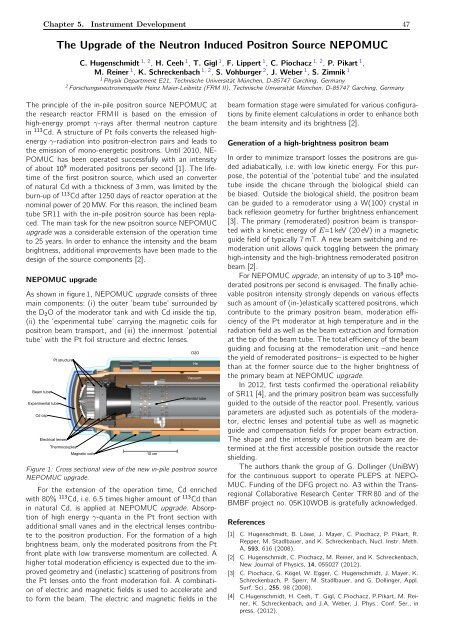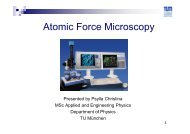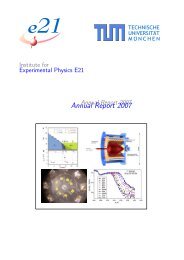Annual Report 2011 / 2012 - E21 - Technische Universität München
Annual Report 2011 / 2012 - E21 - Technische Universität München
Annual Report 2011 / 2012 - E21 - Technische Universität München
Create successful ePaper yourself
Turn your PDF publications into a flip-book with our unique Google optimized e-Paper software.
WENN NICHT ANDERS DEFINIERT:<br />
BEMASSUNGEN SIND IN MILLIMETER<br />
OBERFLÄCHENBESCHAFFENHEIT:<br />
TOLERANZEN:<br />
LINEAR:<br />
WINKEL:<br />
GEZEICHNET<br />
GEPRÜFT<br />
GENEHMIGT<br />
PRODUKTION<br />
QUALITÄT<br />
NAME<br />
OBERFLÄCHENGÜTE:<br />
SIGNATUR<br />
DATUM<br />
WERKSTOFF:<br />
GEWICHT:<br />
ENTGRATEN<br />
UND SCHARFE<br />
KANTEN<br />
BRECHEN<br />
BENENNUNG:<br />
ZEICHNUNGSNR.<br />
MASSSTAB:1:50<br />
ZEICHNUNG NICHT SKALIEREN<br />
BLATT 1 VON 1<br />
ÄNDERUNG<br />
The Upgrade of the Neutron Induced Positron Source NEPOMUC<br />
C. Hugenschmidt 1, 2 , H. Ceeh 1 , T. Gigl 1 , F. Lippert 1 , C. Piochacz 1, 2 , P. Pikart 1 ,<br />
M. Reiner 1 , K. Schreckenbach 1, 2 , S. Vohburger 2 , J. Weber 1 , S. Zimnik 1<br />
1 Physik Department <strong>E21</strong>, <strong>Technische</strong> Universität München, D-85747 Garching, Germany<br />
2 Forschungsneutronenquelle Heinz Maier-Leibnitz (FRM II), <strong>Technische</strong> Universität München, D-85747 Garching, Germany<br />
The principle of the in-pile positron source NEPOMUC at<br />
the research reactor FRM II is based on the emission of<br />
high-energy prompt γ-rays after thermal neutron capture<br />
in 113 Cd. A structure of Pt foils converts the released highenergy<br />
γ-radiation into positron-electron pairs and leads to<br />
the emission of mono-energetic positrons. Until 2010, NE-<br />
POMUC has been operated successfully with an intensity<br />
of about 10 9 moderated positrons per second [1]. The lifetime<br />
of the first positron source, which used an converter<br />
of natural Cd with a thickness of 3 mm, was limited by the<br />
burn-up of 113 Cd after 1250 days of reactor operation at the<br />
nominal power of 20 MW. For this reason, the inclined beam<br />
tube SR11 with the in-pile positron source has been replaced.<br />
The main task for the new psoitron source NEPOMUC<br />
upgrade was a considerable extension of the operation time<br />
to 25 years. In order to enhance the intensity and the beam<br />
brightness, additional improvements have been made to the<br />
design of the source components [2].<br />
NEPOMUC upgrade<br />
As shown in figure 1, NEPOMUC upgrade consists of three<br />
main components: (i) the outer ’beam tube’ surrounded by<br />
the D 2 O of the moderator tank and with Cd inside the tip,<br />
(ii) the ’experimental tube’ carrying the magnetic coils for<br />
positron beam transport, and (iii) the innermost ’potential<br />
tube’ with the Pt foil structure and electric lenses.<br />
Beam tube<br />
Experimental tube<br />
Cd cap<br />
Chapter 5. Instrument Development 47<br />
Pt structure<br />
Electrical lenses<br />
Thermocouples<br />
Magnetic coils<br />
10 cm<br />
D2O<br />
He<br />
Vacuum<br />
Potential tube<br />
Figure 1: Cross sectional view of the new in-pile positron source<br />
NEPOMUC upgrade.<br />
For the extension of the operation time, Cd enriched<br />
with 80% 113 Cd, i.e. 6.5 times higher amount of 113 Cd than<br />
in natural Cd, is applied at NEPOMUC upgrade. Absorption<br />
of high energy γ-quanta in the Pt front section with<br />
additional small vanes and in the electrical lenses contribute<br />
to the positron production. For the formation of a high<br />
brightness beam, only the moderated positrons from the Pt<br />
front plate with low transverse momentum are collected. A<br />
higher total moderation efficiency is expected due to the improved<br />
geometry and (inelastic) scattering of positrons from<br />
the Pt lenses onto the front moderation foil. A combination<br />
of electric and magnetic fields is used to accelerate and<br />
to form the beam. The electric and magnetic fields in the<br />
A3<br />
1611-010-00_farbige Zeichnung Aufbau SR11_andere Schrift<br />
beam formation stage were simulated for various configurations<br />
by finite element calculations in order to enhance both<br />
the beam intensity and its brightness [2].<br />
Generation of a high-brightness positron beam<br />
In order to minimize transport losses the positrons are guided<br />
adiabatically, i.e. with low kinetic energy. For this purpose,<br />
the potential of the ’potential tube’ and the insulated<br />
tube inside the chicane through the biological shield can<br />
be biased. Outside the biological shield, the positron beam<br />
can be guided to a remoderator using a W(100) crystal in<br />
back reflexion geometry for further brightness enhancement<br />
[3]. The primary (remoderated) positron beam is transported<br />
with a kinetic energy of E=1 keV (20 eV) in a magnetic<br />
guide field of typically 7 mT. A new beam switching and remoderation<br />
unit allows quick toggling between the primary<br />
high-intensity and the high-brightness remoderated positron<br />
beam [2].<br />
For NEPOMUC upgrade, an intensity of up to 3·10 9 moderated<br />
positrons per second is envisaged. The finally achievable<br />
positron intensity strongly depends on various effects<br />
such as amount of (in-)elastically scattered positrons, which<br />
contribute to the primary positron beam, moderation efficiency<br />
of the Pt moderator at high temperature and in the<br />
radiation field as well as the beam extraction and formation<br />
at the tip of the beam tube. The total efficiency of the beam<br />
guiding and focusing at the remoderation unit –and hence<br />
the yield of remoderated positrons– is expected to be higher<br />
than at the former source due to the higher brightness of<br />
the primary beam at NEPOMUC upgrade.<br />
In <strong>2012</strong>, first tests confirmed the operational reliability<br />
of SR11 [4], and the primary positron beam was successfully<br />
guided to the outside of the reactor pool. Presently, various<br />
parameters are adjusted such as potentials of the moderator,<br />
electric lenses and potential tube as well as magnetic<br />
guide and compensation fields for proper beam extraction.<br />
The shape and the intensity of the positron beam are determined<br />
at the first accessible position outside the reactor<br />
shielding.<br />
The authors thank the group of G. Dollinger (UniBW)<br />
for the continuous support to operate PLEPS at NEPO-<br />
MUC. Funding of the DFG project no. A3 within the Transregional<br />
Collaborative Research Center TRR 80 and of the<br />
BMBF project no. 05K10WOB is gratefully acknowledged.<br />
References<br />
[1] C. Hugenschmidt, B. Löwe, J. Mayer, C. Piochacz, P. Pikart, R.<br />
Repper, M. Stadlbauer, and K. Schreckenbach, Nucl. Instr. Meth.<br />
A, 593, 616 (2008).<br />
[2] C. Hugenschmidt, C. Piochacz, M. Reiner, and K. Schreckenbach,<br />
New Journal of Physics, 14, 055027 (<strong>2012</strong>).<br />
[3] C. Piochacz, G. Kögel, W. Egger, C. Hugenschmidt, J. Mayer, K.<br />
Schreckenbach, P. Sperr, M. Stadlbauer, and G. Dollinger, Appl.<br />
Surf. Sci., 255, 98 (2008).<br />
[4] C.Hugenschmidt, H. Ceeh, T. Gigl, C.Piochacz, P.Pikart, M. Reiner,<br />
K. Schreckenbach, and J.A. Weber, J. Phys.: Conf. Ser., in<br />
press, (<strong>2012</strong>).




